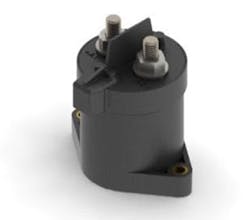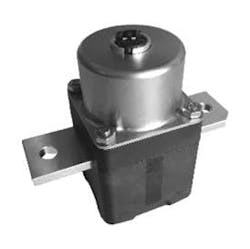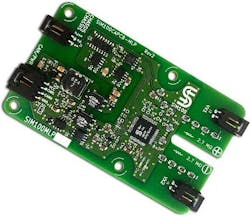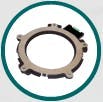Powering the Skies: The Critical Sensor Requirements for Advancing Air Mobility
Advanced air mobility (AAM) is reshaping industries that have defined human progress for decades. Consider aerospace and automotive. At the heart of the industries’ transformation lies electrification, which has become the driving force behind the revolution in air travel. This shift doesn’t just impact vehicles—it extends to every corner of the supply chain, encouraging suppliers and manufacturers to embrace innovation that makes air travel safer, cleaner and more efficient.
Today’s traditional aircraft contribute nearly 3% of global emissions, proving the urgent need for a greener alternative. At the same time, rapid urbanization has heightened the demand for solutions to reduce traffic congestion. Advanced air mobility—fueled by breakthroughs in battery and fuel cell technologies—seeks to address both challenges by reducing carbon footprints and providing a sustainable alternative for urban and regional transportation.
READ MORE: Selecting the Right Sensor: A Guide for R&D and Electronics Design Engineers
But as this exciting future unfolds, the success of AAM depends on more than just propulsion systems and flight designs. To achieve truly transformative outcomes, the aerospace industry must ensure next-generation sensor technologies are developed and deployed. These sensors are the “eyes and ears” of the aircraft, delivering the critical data needed for autonomous flight, collision avoidance, air traffic management and even passenger comfort.
The question now is: What must the aerospace industry do to equip itself with the right sensors to support the development of advanced air mobility?
Electric aircraft use similar components to electric vehicles but have some unique requirements when it comes to component weight, safety and system design. Flight range and payload capacity are directly tied to weight, prompting engineers to make intricate changes to remove even a tenth of a pound from systems and components. Electric aircraft typically have many more electric motors and battery modules or fuel cells, all cross-tied to prevent total loss of electric propulsion in case of failure, which needs additional electrical safety components.
Additionally, the systems and components need to function reliably at high voltage and power (up to 450A and 1,000 Vdc) over a long lifespan. Finally, they must operate under extreme temperatures (−55°C to +85°C), at altitudes from 10,000 to 35,000 ft, and withstand high levels of vibration and shock.
This article will address the product requirements and solutions for high-voltage system circuit protection, isolation monitoring for safety and electric propulsion unit efficiency using example within Sensata Technologies’ portfolio:
High voltage system protection. For high voltage-high power systems, commutation functions are managed by high voltage contactors. These devices handle switching during startup and shutdown and provide short circuit protection. They are often paired with a pyrofuse switch, which can quickly disconnect the battery in a short circuit event.
Sensata Electrified Flight (SELF) contactors offer a lightweight solution with a ceramic to metal brazed header for a hermetic seal that is ideal for EVTOL applications. These contactors are rated from 12 Vdc to 1,000 Vdc, with continuous current ratings up to 600, and meet the DO-160 aerospace standard. The SELF pyrofuse switch provides a fast disconnect time of less than 1 millisecond, with a maximum breaking capacity of 1,000 Vdc, 16kA, and a continuous current carry rating of 500 amps.
Isolation monitoring for safety. The Insulation Monitoring Device (IMD) operates effectively even with active batteries experiencing large voltage variations. It detects all leakage sources, including multiple simultaneous symmetrical and asymmetrical faults, and resistive paths between the chassis and battery points with the same potential.
The IMD continuously monitors and uses an algorithm for high noise rejection, estimating new isolation resistance values twice per second. In case of an insulation fault, it identifies the fault’s relative position to the battery terminals and measures capacitance from each terminal to the chassis. The IMD’s enhanced performance demonstrates Sensata’s capability in addressing complex current and voltage measurement challenges.
Electric propulsion unit efficiency. The adoption of electric motors (e-motors) in aircraft such as UAM, AAM and eVTOL has created an immediate demand for accurate, low-profile position sensors that achieve efficiency similar to axial flux e-motors. Axial flux e-motors feature a gap between the rotor and stator, with the direction of magnetic flux parallel to the axis of rotation.
In contrast, conventional e-motor magnets are radially oriented. Radial flux e-motors require non-grain-oriented steel due to their two-dimensional magnetic flux path. However, axial flux e-motors benefit from a unidirectional magnetic flux path, allowing the use of grain-oriented electrical steel, which has higher permeability and reduces iron losses, thereby increasing motor efficiency.
To ensure optimal efficiency of the axial flux motor, knowing the rotor’s positional accuracy is crucial. Sensata’s SELF-EDP rotary position sensor offers a revolutionary solution compared to traditional resolvers. Unlike resolvers, which are heavier, have a higher profile, and require off-board electronics, the SELF-EDP sensor is lightweight, low-profile, magnet-free and can have a built-in redundant channel. It provides accuracy of ≤±1 deg. over its lifespan and is adaptable to custom motor diameters, pole-pair counts, and mounting positions. Additionally, it is robust against vibration, dust, humidity, oil and wear debris.
The Advanced Air Mobility (AAM) market is experiencing rapid growth, with production rates expected to reach thousands of aircraft per year. In addition to sensor technologies, charging infrastructure will play a pivotal role in this transformation.
WATCH: The Role of Advanced Sensors in Propellant Technology
Sensata Technologies is addressing these infrastructure needs through its comprehensive range of high voltage components, including Dynapower charging infrastructure and a broader Contactor portfolio. These components and systems will play a vital role in enhancing eVTOL performance.
Traditional aircraft produce 3% of global emissions. At the same time, population growth in large cities is creating demand for transportation methods to relieve congestion. Over the last decade, advances in battery and fuel cell technology are enabling the advanced aircraft air mobility revolution. This movement aims to reduce the aircraft emissions, address congestion in large cities, and create more cost effective regional air transportation.
About the Author

Darren Magas
Senior Product Manager Aerospace Business, Sensata Technologies
Darren Magas is a seasoned senior product and business development manager with more than 20 years of experience in the aerospace industry, specializing in the transition to sustainable energy solutions such as battery-electric and hydrogen fuel cell technologies. His expertise lies in driving innovation and leading cross-functional teams to develop cutting-edge products that accelerate the industry's shift toward greener, more efficient aviation.




